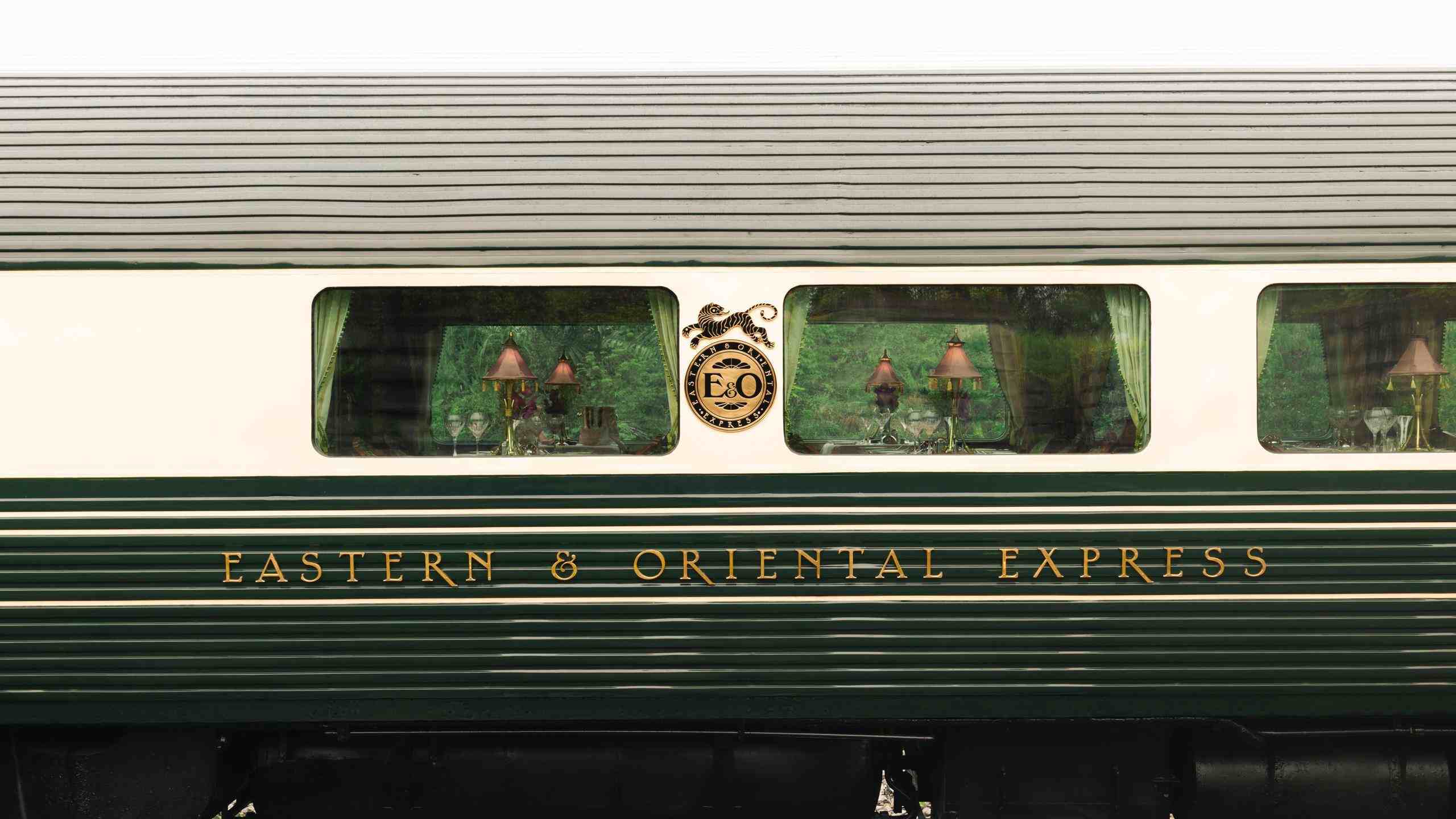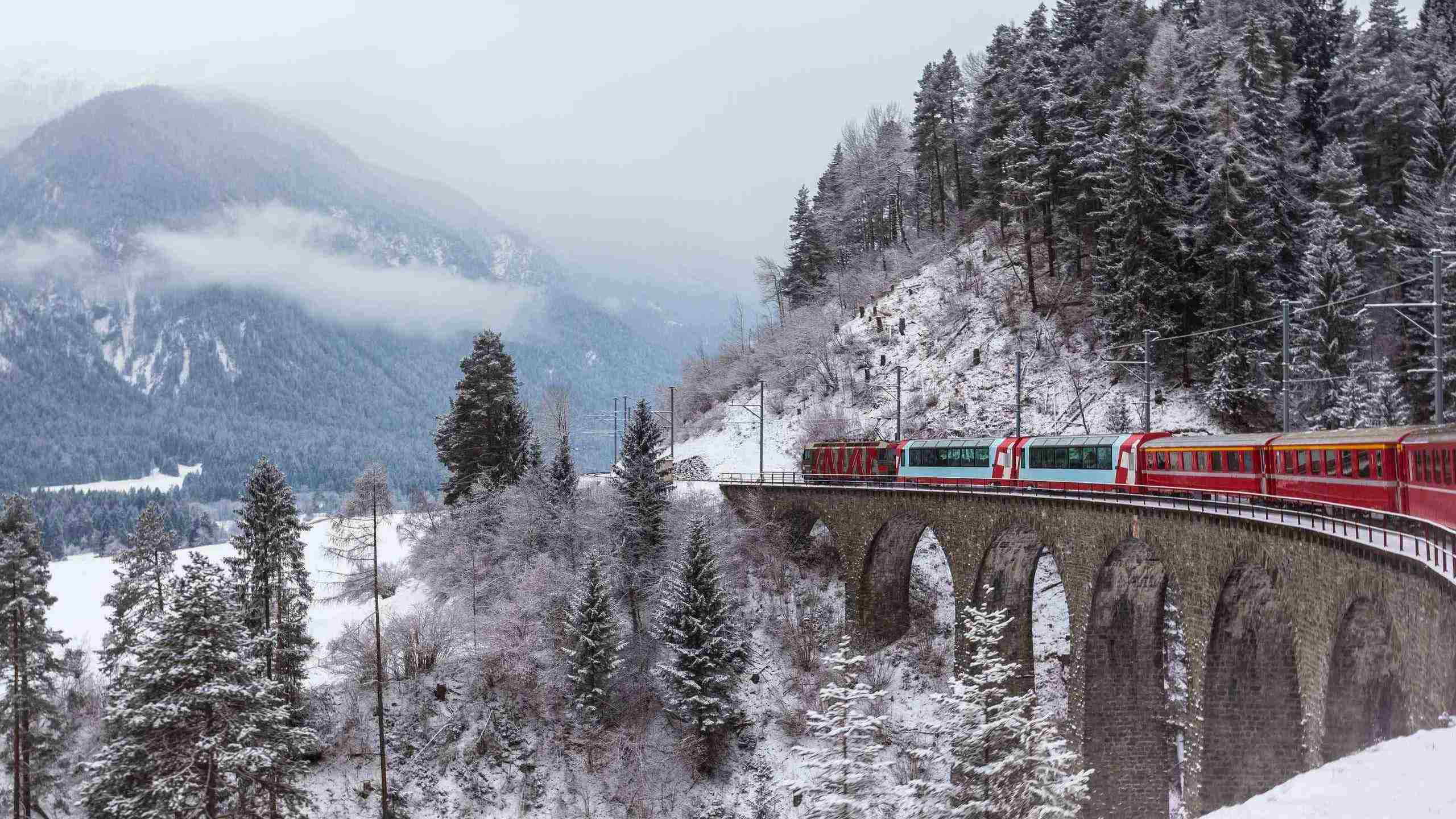The world is just outside your window when you travel by train. The original form of luxury travel sees you glide across vast distances, traverse wide open spaces and crisscross busy cities, all the while cocooned in a cosy, perfectly formed carriage. As you journey, peacefully and slowly, chances to savour moments of genuine, unhurried connection unfold.
Trains, with their hypnotic, gentle rock, have long been one of the most luxurious ways to travel. The first leap into this decadent realm took place in the mid-1800s when rudimentary train carriages received a makeover fit for a Hollywood movie star. Tracks that once carried coal, iron and steel now transported five-star moving hotels too; linear labyrinths of opulent cabins, secret compartments, peaceful libraries and ornate dining cars.
Later, as time went on, new routes stretched out far and wide, traversing some of the most beautiful parts of the globe. Meanders became possible along Europe’s snowy mountain passes, across vast African savannas, through Australia’s neverending Outback, between classical capital cities and through emerald green Asian tea estates and rice paddies.


The origins of luxury

The name Pullman is synonymous with luxury trains, evoking images of steam locomotives powering through beautiful landscapes: symbols of romance and splendour. George Pullman was an American engineer and industrialist born in New York in 1831. As the son of a carpenter, he initially followed in his father’s footsteps before expanding his business to the railroads. The country was on the brink of the industrial revolution, and there were opportunities for visionary entrepreneurs like Pullman.
After a particularly uncomfortable overnight train journey, Pullman was inspired to pursue the development of his very own ‘palace car’ – a sleeper carriage that could offer the same comfort as any luxury hotel. Part of the comfortable design included ‘paper car wheels’ that ensured a smooth journey, essential for the sort of first-class travel Pullman hoped to deliver; think sipping aperitifs from crystal glasses, indulging in delicate canapés and, of course, a good night’s sleep.

The manufacturing of Pullman’s special sleeper cars was a success and by 1872 the United Kingdom wanted one for themselves. The parts were imported from Illinois and the beautiful Midland coach was built in England, replicating the heady luxury Pullman had captured in America. The inaugural journey ran from Bradford Forster Square to London St Pancras, billowing steam stretching out along the rolling green hills of the English countryside.
This injection of glitz and glamour to the hard-working grit of industrial railways continued across Europe. In 1883, Belgian engineer Georges Nagelmackers unveiled the first version of the Orient Express. This luxurious hotel-on-tracks departed from Paris on 4th October 1883, on a seven–day journey bound for Constantinople (Istanbul) carrying 40 passengers.
The early Pullman trains and the Orient Express exude a timeless elegance in their decor, design and service. Extremely high levels of detail, both practical and indulgent, had to be met to ensure a seamless, smooth experience while in such close, moving quarters.

James Wakelin
Travel Designer

The devil is in the details

The early Pullman trains and the Orient Express exude a timeless elegance in their decor, design and service. Extremely high levels of detail, both practical and indulgent, had to be met to ensure a seamless, smooth experience while in such close, moving quarters.
White-gloved stewards became magicians, conjuring up the sort of top-notch service usually reserved for the finest hotels, yet with two big disadvantages, much less space and almost constant movement. Like master illusionists, they would slip through a narrow, lacquered wooden doorway, only to reappear through another, balancing a silver tray laden with champagne flutes, the fizzing liquid moving in time with the train’s sway, never spilling. The magic would continue with an endless appearance of new and wondrous treats; afternoon teas, elaborate meals, musical entertainment, cocktails and much more.
There was even a touch of wizardry in the clerestory design of the roofs, a feature previously unseen in train carriage construction. The rooftops were raised allowing for narrow windows to be inserted above the eyeline, increasing the flow of natural light and making the carriage feel larger than its actual size. At breakfast time, Pullman’s innovative stowed-berth design would be put into action. Attendants would enter the cabins and within minutes remove the remnants of night. Beds would be stowed in the ceiling, linens tidied into hidden compartments and comfortable upholstered armchairs revealed, transforming the space for a day of travel with just a few clever tricks and clicks.
In addition to their ingenious design, the luxurious details on these trains were staggering. Even the very first Pullman train that ran across America in 1874 featured thick, soft carpets, observation balconies, walnut inlay woodwork, silver framed mirrors, French upholstery and surprisingly comfortable mattresses. There was no chance of feeling chilly either, with underfloor heating running throughout each carriage.

The original luxury on the tracks of today
Modern luxury train travel has naturally evolved since the 1800s. The glamorous Orient Express and Pullman trains have been reimagined with new design and technologies. Today, some sleeper carriages boast spacious marble ensuites, electric intercoms to call upon your 24-hour butler, onboard boutiques and baby grand pianos in the bar.
There’s a host of new routes and destinations to explore around the globe too. The Venice Simplon-Orient Express still winds its way to some of Europe’s most mesmerising capitals and through stunning natural landscapes. In Asia, there are new routes from Singapore into Malaysia. One–night adventures can start in the romantic French capital with journeys high into the snowy Alps then on to the culture-rich and historical capitals of Prague, Budapest, Rome, Vienna and Florence.

A longer trip, reminiscent of the train’s maiden voyage, follows the tracks through Austria and Hungary before pausing in the pretty Romanian mountain village of Sinaia. Here, in 1883 the original Orient Express guests were invited by the king to visit his fairytale home, Peles Castle, situated in the dramatic Carpathian Mountains. And, if you take this route today, the tradition of visiting the castle remains.
After the myths, legends and beauty of rural Romania, the train continues to Bucharest, crossing the mighty Danube River on the impressive Cernavoda Bridge. The train then ventures into Bulgaria, the Black Sea almost visible in the east as it continues to the transcontinental city of Istanbul.

Back in the United Kingdom, the Pullman name still presides over English luxury train travel. The current British Pullman, a Belmond train, exudes elegance, made up of lovingly restored carriages dating back as early as 1925. The original essence of grand train travel has been captured in the antique furniture, intricate marquetry, vintage lighting, heritage upholstery and impeccable first–class service.
Routes and experiences are scrupulously married together to give revellers a brief sojourn to a bygone era and a snapshot of some of the most beautiful parts of England. Journeys today offer a taste, quite literally, of utter luxury.
Take the Garden of England route for example. The train speeds out of London’s Victoria station towards Kent, circling the county. The route rolls past the orchards, farms and coastline from where the wine and food served onboard is sourced. On this perfectly formed day-long excursion you’re served locally produced sparkling wine followed by a five-course feast of Kent’s finest quality produce – asparagus, cherries, Romney Marsh lamb and Whitstable oysters.

A glance at luxury across the globe
Along with the trains that spearheaded the journey into luxury, there’s another, relatively newer web of routes to discover. Some are day trips turned exquisite adventures while others promise an immersive sleeper journey, harking back to the original carriages created by Pullman.

In Switzerland, the Glacier Express, a red rocket-like train with a distinctively modern feel in its spacious carriages, serves delicious Swiss traditional dishes and fine wines from Graubünden and Valais. Incredibly, in just one day the train takes you across hundreds of small bridges, through dozens of tunnels and passes by some of the country’s most stunning landmarks. Incredibly, it’s possible to see the massive Matterhorn peak, the pretty villages of Zermatt, Andermatt and St Moritz, the Rhine Gorge, Oberalp Pass and cross the iconic Landwasser Viaduct – plus several other highlights.
Leaving Europe for Peru offers an opportunity for a truly epic train trip, taking less than a day. Deep within the valleys of the Andes, charming train stations and winding tracks whisk visitors to a world of ancient Incan history and mesmerising beauty, Machu Picchu. Named after the first foreigner to discover the citadel, the Hiram Bingham train harnesses the anticipation of 20th-century explorers, and adds a large dose of luxury and Peruvian soul.

Journeying to Machu Picchu from Cusco heralds mid-morning cocktails, brunch, lunch and a palpable excitement as the train follows the rushing Vilcanota River to the little town of Aguas Calientes. After visiting the mighty Incan citadel the feeling onboard is jubilant as the train winds its way back through the Sacred Valley to Cusco. The journey to Cusco from Machu Picchu takes around three hours, with dinner, cocktails and a celebratory, party-like atmosphere fueled by live Peruvian music.
On the other side of the globe, in the hot, humid climate of Malaysia, an exquisite train saunters along tracks that lead from some of Asia’s most enigmatic urban hubs to stunning natural landscapes. The Eastern and Oriental Express is a masterpiece that combines the grandeur of her sister train in Europe and the culture of Indochina.
Traditional lacquered woods mingle elegantly with the finest silks, adorned with motifs of Asian elephants, leopards and tigers. Much like her counterpart, expect overnight sleeper journeys to get you deep into the soul of this wonderful part of the world.
This exceptional train operates a handful of carefully considered routes; some are seasonal to coincide with festivities, while others promise a jaw-dropping and mouth-watering deluge of highlights. Itineraries invite you to lie on the white-sand beaches of Langkawi, explore vibrant marine life in Pulau Payar Marine Park, savour dishes during Peranakan cooking classes in Penang and wander the jungle pathways of Taman Negara National Park, one of the oldest tropical rainforests in the world.
WORDS BY: Emily Opie
If you're ready to start planning your own epic train journey, our travel designers are ready to help.




















